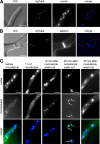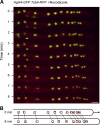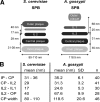Mobility, microtubule nucleation and structure of microtubule-organizing centers in multinucleated hyphae of Ashbya gossypii
- PMID: 19910487
- PMCID: PMC2801712
- DOI: 10.1091/mbc.e09-01-0063
Mobility, microtubule nucleation and structure of microtubule-organizing centers in multinucleated hyphae of Ashbya gossypii
Abstract
We investigated the migration of multiple nuclei in hyphae of the filamentous fungus Ashbya gossypii. Three types of cytoplasmic microtubule (cMT)-dependent nuclear movements were characterized using live cell imaging: short-range oscillations (up to 4.5 microm/min), rotations (up to 180 degrees in 30 s), and long-range nuclear bypassing (up to 9 microm/min). These movements were superimposed on a cMT-independent mode of nuclear migration, cotransport with the cytoplasmic stream. This latter mode is sufficient to support wild-type-like hyphal growth speeds. cMT-dependent nuclear movements were led by a nuclear-associated microtubule-organizing center, the spindle pole body (SPB), which is the sole site of microtubule nucleation in A. gossypii. Analysis of A. gossypii SPBs by electron microscopy revealed an overall laminar structure similar to the budding yeast SPB but with distinct differences at the cytoplasmic side. Up to six perpendicular and tangential cMTs emanated from a more spherical outer plaque. The perpendicular and tangential cMTs most likely correspond to short, often cortex-associated cMTs and to long, hyphal growth-axis-oriented cMTs, respectively, seen by in vivo imaging. Each SPB nucleates its own array of cMTs, and the lack of overlapping cMT arrays between neighboring nuclei explains the autonomous nuclear oscillations and bypassing observed in A. gossypii hyphae.
Figures









Similar articles
-
Electron tomography of the microtubule cytoskeleton in multinucleated hyphae of Ashbya gossypii.J Cell Sci. 2012 Dec 1;125(Pt 23):5830-9. doi: 10.1242/jcs.111005. Epub 2012 Sep 26. J Cell Sci. 2012. PMID: 23015595
-
Dynamics of multiple nuclei in Ashbya gossypii hyphae depend on the control of cytoplasmic microtubules length by Bik1, Kip2, Kip3, and not on a capture/shrinkage mechanism.Mol Biol Cell. 2010 Nov 1;21(21):3680-92. doi: 10.1091/mbc.E10-06-0527. Epub 2010 Sep 15. Mol Biol Cell. 2010. PMID: 20844079 Free PMC article.
-
Structural mutants of the spindle pole body cause distinct alteration of cytoplasmic microtubules and nuclear dynamics in multinucleated hyphae.Mol Biol Cell. 2010 Mar 1;21(5):753-66. doi: 10.1091/mbc.e09-07-0555. Epub 2010 Jan 6. Mol Biol Cell. 2010. PMID: 20053682 Free PMC article.
-
Role of nucleation in cortical microtubule array organization: variations on a theme.Plant J. 2013 Jul;75(2):270-7. doi: 10.1111/tpj.12166. Epub 2013 Apr 1. Plant J. 2013. PMID: 23464654 Review.
-
Anatomy of the fungal microtubule organizing center, the spindle pole body.Curr Opin Struct Biol. 2021 Feb;66:22-31. doi: 10.1016/j.sbi.2020.09.008. Epub 2020 Oct 25. Curr Opin Struct Biol. 2021. PMID: 33113389 Free PMC article. Review.
Cited by
-
Organization of organelles within hyphae of Ashbya gossypii revealed by electron tomography.Eukaryot Cell. 2013 Nov;12(11):1423-32. doi: 10.1128/EC.00106-13. Epub 2013 Jun 14. Eukaryot Cell. 2013. PMID: 23771903 Free PMC article.
-
Heterogeneity in mitochondrial morphology and membrane potential is independent of the nuclear division cycle in multinucleate fungal cells.Eukaryot Cell. 2012 Mar;11(3):353-67. doi: 10.1128/EC.05257-11. Epub 2012 Jan 20. Eukaryot Cell. 2012. PMID: 22267774 Free PMC article.
-
Sporulation in Ashbya gossypii.J Fungi (Basel). 2020 Aug 29;6(3):157. doi: 10.3390/jof6030157. J Fungi (Basel). 2020. PMID: 32872517 Free PMC article. Review.
-
Interaction of the Aspergillus nidulans microtubule-organizing center (MTOC) component ApsB with gamma-tubulin and evidence for a role of a subclass of peroxisomes in the formation of septal MTOCs.Eukaryot Cell. 2010 May;9(5):795-805. doi: 10.1128/EC.00058-10. Epub 2010 Mar 26. Eukaryot Cell. 2010. PMID: 20348383 Free PMC article.
-
Energide-cell body as smallest unit of eukaryotic life.Ann Bot. 2018 Nov 3;122(5):741-745. doi: 10.1093/aob/mcy022. Ann Bot. 2018. PMID: 29474513 Free PMC article.
References
-
- Alberti-Segui C., Dietrich F., Altmann-Johl R., Hoepfner D., Philippsen P. Cytoplasmic dynein is required to oppose the force that moves nuclei towards the hyphal tip in the filamentous ascomycete Ashbya gossypii. J. Cell Sci. 2001;114:975–986. - PubMed
-
- Ayad-Durieux Y., Knechtle P., Goff S., Dietrich F., Philippsen P. A PAK-like protein kinase is required for maturation of young hyphae and septation in the filamentous ascomycete Ashbya gossypii. J. Cell Sci. 2000;113:4563–4575. - PubMed
-
- Bullitt E., Rout M. P., Kilmartin J. V., Akey C. W. The yeast spindle pole body is assembled around a central crystal of Spc42p. Cell. 1997;89:1077–1086. - PubMed
-
- Byers B., Goetsch L. Duplication of spindle plaques and integration of the yeast cell cycle. Cold Spring Harb. Symp. Quant. Biol. 1974;38:123–131. - PubMed
Publication types
MeSH terms
LinkOut - more resources
Full Text Sources

